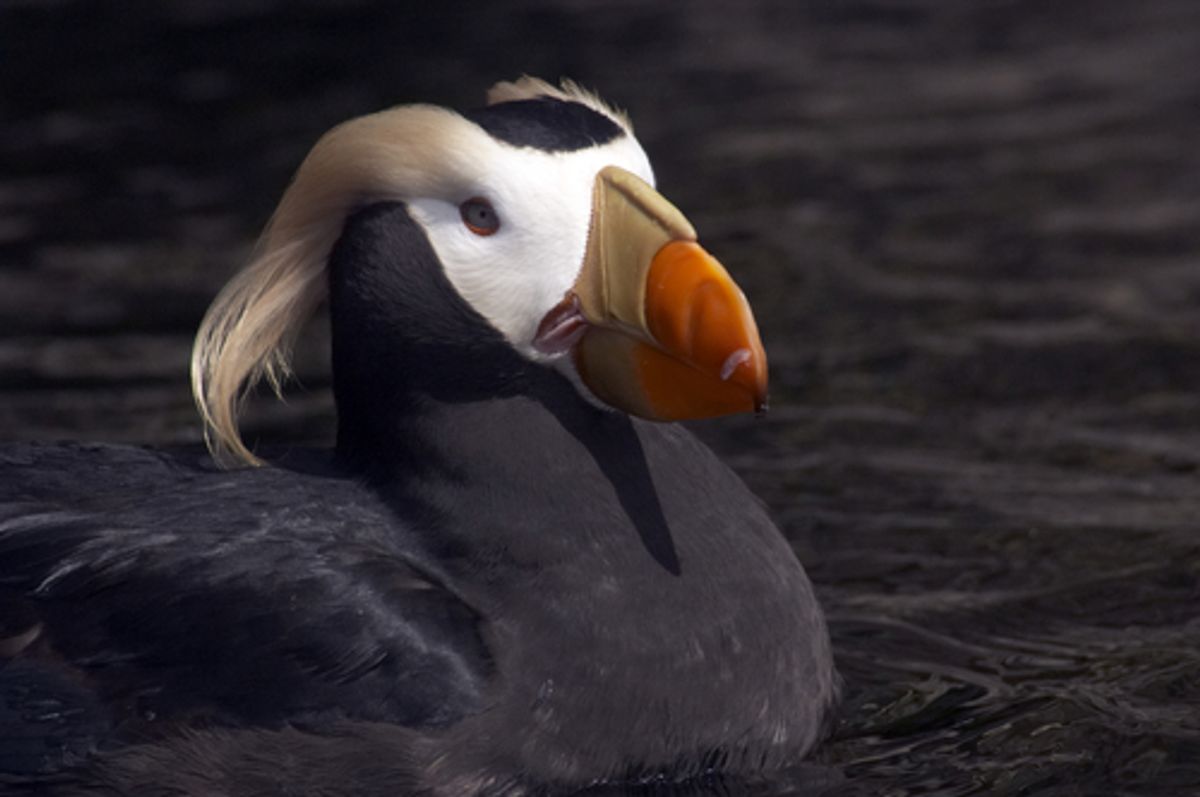 It’s hard not to love the tufted puffin. Just a little bigger than a football and not altogether different in shape, this bird’s bright orange beak and mad scientist-like tufts make it a standout on cliffs above the Pacific. Unlike their tuxedo-wearing Atlantic cousins, tufted puffins wear all black, but these pelagic punks are having a rough time on our western coastline.
It’s hard not to love the tufted puffin. Just a little bigger than a football and not altogether different in shape, this bird’s bright orange beak and mad scientist-like tufts make it a standout on cliffs above the Pacific. Unlike their tuxedo-wearing Atlantic cousins, tufted puffins wear all black, but these pelagic punks are having a rough time on our western coastline.
In just 30 years, tufted puffin populations in Washington, Oregon, and California have plummeted as much as 90 percent, thanks to habitat destruction, fishing practices, and troubles with invasive species. That’s why the Natural Resources Defense Council (which publishes OnEarth) filed a petition with the U.S. Fish and Wildlife Service today, requesting that tufted puffins of the Lower 48 receive protections under the Endangered Species Act.
On this side of the Pacific, the puffin’s historic range extends from Alaska down to almost Mexico, but the farther south you go, the fewer birds you’ll see. Although large populations of tufted puffins appear stable in Alaska, at last count, Washington had only 3,000 breeding individuals, while Oregon and California had fewer than 300 each. According to Brad Sewell, a senior attorney at NRDC, these more southerly birds represent a distinct population segment that deserves protection.
“At a biological level, it’s really important to preserve the puffin’s genetic diversity and geographic range of the species,” says Sewell. Diversity, both genetic and geographic, helps species evolve and adapt to long-term threats such as climate change as well as survive cataclysmic events, such as a massive oil spill. (The 1989 Exxon Valdex disaster in Alaska killed as many as 13,000 tufted puffins.)
Puffins spend most of their lives on the high seas, returning to shore only for mating and raising young. And each time a puffin comes ashore is a time of great vulnerability. Case in point: Destruction Island. This small crag of land off Washington previously went by “the Island of Sorrows” but for puffins, both names are apt. The birds once nested here in sizeable numbers, until settlers brought European rabbits to the place. Bunnies don’t eat puffins, of course, but they do disturb their nesting sites and overgraze the island’s grasses, which leads to erosion (bad news for a bird living on a cliff). The rabbits also attract large predators like bald eagles (bad news for just about anything smaller than a bald eagle).
Human activity, competition from other seabirds, and other forms of erosion have also caused puffins to abandon breeding sites along the western coast. And once these birds leave a spot, they’re unlikely to return. Puffins practice what’s known as natal site fidelity, or breeding at one’s birthplace. If they can’t breed there, they may not breed anywhere.
Making matters worse is that puffins mate for life and produce only one offspring each year. And once that chick grows up, it could take the bird a year just to build a nesting burrow of its own. Should something happen to that nest (via landslide or rabbit), the young puffin could lose an entire year of its reproductive life.
At sea, life isn’t much easier for these birds. Puffins dive below the ocean’s surface—up to 200 feet!—to snatch squid, crab, jellyfish, zooplankton, and my favorite, a face full of fish. Climate change could disrupt this smorgasbord in the future, however, and studies have shown that the size of forage fish directly affect chick development and health. In the meantime, puffins need to watch out for fishermen. Those deep dives put the seabirds in the way of driftnets and many puffins die this way each year. Between 1992 and 2001, Japanese salmon fisherman snared 35,444 tufted puffins while fishing in Russian waters.
It’s little wonder only 4,000 of these guys remain in the contiguous United States, and according to Sewell, a patchwork of state-level protections won’t be enough to keep them around. A federal listing under the Endangered Species Act would help protect the birds from hunting, harassment, and becoming bycatch and possibly even safeguard its food supply from overfishing. Which would mean, of course, … more fish-faced photo ops.



Shares